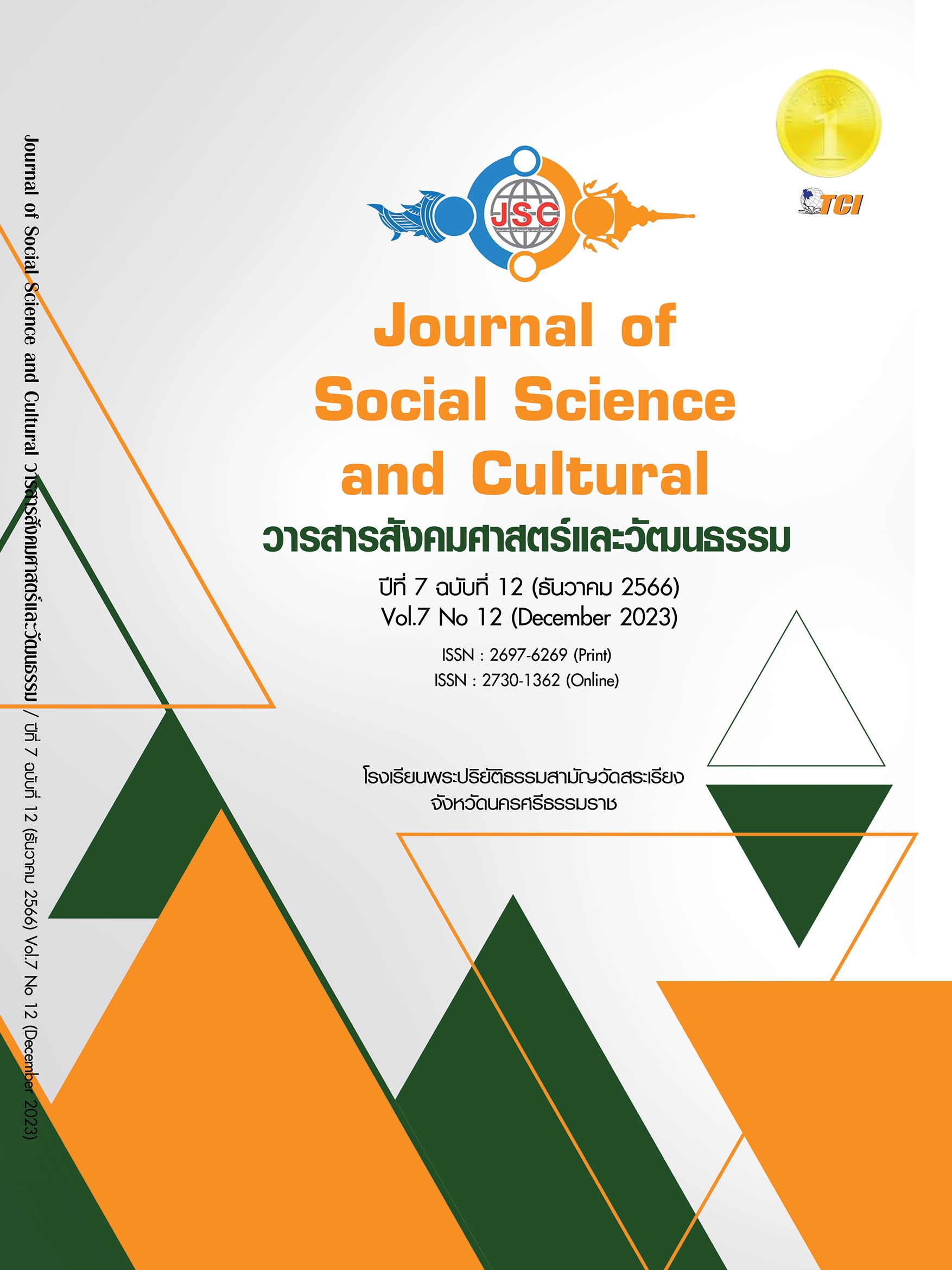DEVELOPMENT OF A MODEL TO PROMOTE MATHEMATICALTHINKING AMONG UPPER SECONDARY SCHOOL STUDENTS USING SELF - DIRECTED LEARNING AND PROJECT - BASED LEARNING
Main Article Content
Abstract
The objectives of this research are as follows: 1) to develop a learning model based on self - directed learning and project - based learning to enhance mathematical thinking; 2) to study the effectiveness of implementing the developed learning model based on self - directed and project - based learning in the aspect of mathematical thinking and the satisfaction of learning model based on self - directed learning and project - based learning. The subjects of research were 35 Grade 11 students who were selected by the cluster random sampling and attended 32 periods at 50 minutes per period in the first semester of the 2023 academic year. The research instruments consisted of a lesson plan based on self - directed and project - based learning, a mathematical thinking test and a questionnaire on satisfaction through model of learning. The data were analyzed by using mean, standard deviation and t - test. The results revealed the following: 1) the learning model was based on self - directed learning and project - based learning and had four main components; principles, objectives, steps of teaching and assessment and evaluation of learning model. The steps of learning model consisted of seven steps: 1) observing the needs of the students; 2) selecting learning problems; 3) problem - solving; 4) learning outside the classroom; 5) managing the learning process; 6) summarizing and presenting; and 7) reflection and the learning process. ; (2) the results of the effectiveness of implementing the developed learning model demonstrated the following: 2.1) the post - test mathematical thinking scores of the upper high school students were significantly higher than the pre - test at .05 level; the mean scores on the pre - test was 18.69 (S.D. = 4.40) . On the other hand, the mean scores of the post - test were 48.81 (5.71); and 2.2) overall student satisfaction through self - directed learning and project - based learning was at the highest level ( = 4.76, S.D. = 0.46)
Article Details
References
กาญจนา นิลนวล. (2565). รูปแบบการจัดการเรียนรู้ตามทฤษฎีพัฒนาการพุทธิปัญญาเพื่อส่งเสริมความสามารถการแก้ปัญหาทางคณิตศาสตร์ของนักเรียนชั้นประถมศึกษาปีที่ 6. ใน ดุษฎีนิพนธ์ปริญญาดุษฎีบัณฑิต สาขาวิชาหลักสูตรและการสอน. มหาวิทยาลัยมหาสารคาม.
เขมณัฏฐ์ มิ่งศิริธรรม. (2552). การเรียนรู้บนเครือข่าย. วารสารศึกษษศษสตร์ มหาวิทยาลัยขอนแก่น, 32(1), 6-13.
ทิศนา แขมมณี. (2560). ศาสตร์การสอน ศาสตร์การสอน : องค์ความรู้เพื่อกระบวนการเรียนรู้ที่มีประสิทธิภาพ (พิมพ์ครั้งที่ 21). กรุงเทพมหานคร: สำนักพิมพ์แห่งจุฬาลงกรณ์มหาวิทยาลัย.
ประภัสสร วงษ์ดี. (2561). รูปแบบการเรียนรู้โดยใช้โครงงานเป็นฐานเพื่อส่งเสริมความสามารถในการทำวิจัยในชั้นเรียนของนักศึกษาครูสาขาช่างอุตสาหกรรม. วารสารศึกษาศาสตร์ มหาวิทยาลัยนเรศวร, 21(1), 109-126.
รุ่งทิวา นาบำรุง. (2550). วิถีธรรมชาติแห่งการคิดเชิงคณิตศาสตร์เรื่องการคูณและการหารของเด็กที่มีอายุตั้งแต่ 7 - 10 ปี. ใน ดุษฎีนิพนธ์ปริญญาปรัชญาดุษฎีบัณฑิต สาขาคณิตศาสตรศึกษา. มหาวิทยาลัยศรีนครินทรวิโรฒ.
วัฒนาพร ระงับทุกข์. (2545). เทคนิคและกิจกรรมการเรียนรู้ที่เน้นผู้เรียนเป็นสําคญตามหลักสูตรการศึกษาขั้นพื้นฐาน พ.ศ. 2544. กรุงเทพมหานคร:: พริกหวานกราฟฟิค.
วีรยุทธ พลายเล็ก. (2562). การพัฒนารูปแบบการเรียนการสอนตามแนวคิด Active Learning เพื่อเสริมสร้าง ทักษะและกระบวนการและจิตคณิตศาสตร์สำหรับนักเรียนชั้นประถมศึกษา. ใน ดุษฎีนิพนธ์ปริญญาดุษฎีบัณฑิต สาขาวิชาหลักสูตรและการสอน. มหาวิทยาลัยศิลปากร.
สมคิด อิสระวัฒน์. (2541). รายงานการวิจัยเรื่องลักษณะการอบรมเลี้ยงดูของคนไทยในชนบทซึ่งมีผลต่อการเรียนรู้ด้วยตนเอง. กรุงเทพมหานคร: ภาควิชาศึกษาศาสตร์ คณะสังคมศาสตร์และมนุษยศาสตร์ มหาวิทยาลัยมหิดล.
สำนักงานคณะกรรมการการศึกษาขั้นพื้นฐาน. (2551). ตัวชี้วัดและสาระการเรียนรู้แกนกลาง กลุ่มสาระการเรียนรู้คณิตศาสตร์ (ฉบับปรับปรุง พ.ศ. 2560) ตามหลักสูตรแกนกลางการศึกษาขั้นพื้นฐาน พุทธศักราช 2551. กรุงเทพมหนคร: ชุมชนสหกรณ์การเกษตรแห่งประเทศไทย จำกัด.
สุธินันท์ บุญพัฒนาภรณ์. (2559). การพัฒนาหลักสูตรเพื่อส่งเสริมการคิดเชิงคณิตศาสตร์สำหรับผู้เรียนชั้นมัธยมศึกษาปีที่ 4. ใน ดุษฎีนิพนธ์ปริญญาปรัชญาดุษฎีบัณฑิต สาขาวิทยาการทางการศึกษาและการจัดการเรียนรู้. มหาวิทยาลัยศรีนครินทรวิโรฒ.
สุวัฒน์ วัฒนวงศ์. (2551). รวมบทความแนวคิดทางอาชีวศึกษาและการศึกษาผู้ใหญ่. กรุงเทพมหานคร: สํานักพิมพ์แห่งจุฬาลงกรณ์มหาวิทยาลัย.
อัมพร ม้าคนอง. (2558). คณิตศาสตร์สำหรับครูมัธยม. (พิมพ์ครั้งที่ 9). กรุงเทพมหานคร: จุฬาลงกรณ์มหาวิทยาลัย.
Joyce, B. R. et al. (2004). Models of teaching (7th ed ed.). Boston: Pearson/Allyn and Bacon.
Joyce, W. (2009). Model of teaching (5th ed ed.). Boston: Aliyn & Bacon.
Marlowe, C. A. (2012). The effect of the flipped classroom on student achievement and stress. In Master of Science Science Education. Montana State University.
NCTM. (2000). Principle and Standards for School Mathematics. United States of America: NCTM.
OECD. (2018). PISA 2018 results. Retrieved April 12 , 2021, from https://www.oecd.org /pisa/publications/pisa - 2018 - results.htm
Poya, G. (1957). How to Solve it. New York: Doubleday & Company.


